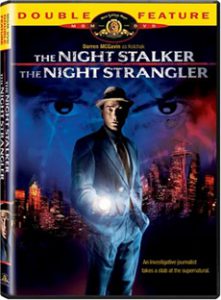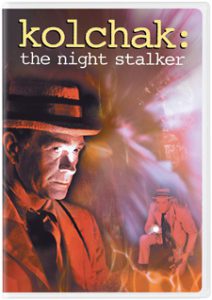Like most people who weren’t around when it was on the air, I was inspired to check out “Kolchak: The Night Stalker” (1974-75) – and its preceding TV movies, “The Night Stalker” (1972) and “The Night Strangler” (1973) – because I’m an “X-Files” fan. “Kolchak” is often cited as the biggest inspiration and influence behind Chris Carter’s landmark show.
Only superficially like ‘X-Files’
In a future post, I’ll outline distinct similarities between the two franchises, but the thing that struck me most on this viewing is how Jeff Rice’s show (and the TV movies he co-wrote with horror legend Richard Matheson) isn’t very much like “The X-Files,” aside from sharing the genre of paranormal investigations.
It’s not even like the idea I had in my head of what “Kolchak” would be (essentially 2005’s “Night Stalker,” but with Darren McGavin). Rather, “Kolchak” is like a parody of what it never was. It’s never scary, the low budget is always obvious (it uses the same establishing shots of Chicago and the INS building in every episode), and even when it’s serious it’s hard to take it seriously.

“Kolchak: The Night Stalker” (1973-75)
ABC, 20 episodes and two TV movies
Creator: Jeffrey Grant Rice
Stars: Darren McGavin, Simon Oakland, Jack Grinnage
Never fear, though, I’m not going off on a rant about how “Kolchak” is terrible. Once I adjusted to what the series IS, I liked it (for what it is).
Obsessed with his job
After a complete viewing of the series, “The Night Stalker” and “The Night Strangler” have to be categorized as false starts toward its identity. In those movies, Carl Kolchak (McGavin) is the newspaper profession’s answer to James Bond: In “Stalker,” his prostitute girlfriend genuinely wants to marry him, and Kolchak is somewhat agreeable to that, but you get a sense that he’d be doing it on a lark.
After that pairing fizzles, Carl hits it off with a belly dancer in “Strangler,” but platonically; this kicks off a random-female-sidekick-of-the-week (or most weeks) approach while Kolchak is repositioned as someone entirely obsessed with his job.
Or rather: what he sees as his job. That’s the crux of the conflict between Kolchak and, well, everyone else, but primarily his editor at the Chicago branch of the Independent News Service, Tony Vincenzo (Simon Oakland). Vincenzo wants to run a straight-laced, respectable newspaper wire service, but Carl digs up stories of the paranormal throughout the Windy City in the 20-episode series proper.
In “The Night Stalker,” they are working together in Las Vegas, and in “The Night Strangler,” they are working together in Seattle, and at one point Kolchak lists a whole bevy of cities he has worked in. The series itself never mentions the bizarre fact that these two are now working together at their third different outfit, and indeed, it doesn’t quite track, since Vincenzo is continually frustrated by Carl blowing off his assignments to track down monsters. Why would he keep hiring him?

The clashes between Vincenzo and Kolchak in the INS office are the heart of the show, and this is the main reason why “Kolchak” is so different from “The X-Files.” While the Mulder-vs.-Skinner shouting matches are entertaining, they are certainly not a focal point.
Accelerating toward comedy
On “Kolchak,” some laughs come from sharp one-liners (“Would you believe that two plus two equals four?!” Carl hotly asks his dense boss), but mostly it’s just fun to watch the two top-notch actors go at it.
Another antagonist is the police detective, which is a different person every week, presumably owing to these crimes taking place in different precincts. The lead cop is usually aggressively anti-reporter, and particularly anti-Kolchak, and often for no good reason.
While Kolchak gets much too close to the action in shootouts and showdowns for his own safety, and while he tramples through crime scenes and picks up murder weapons in later episodes, his behavior is never the reason for the cops hating him. They always hate him because he’s a reporter, as if it’s a matter of policy.
I gradually realized (or chose to accept) that this is not bad writing (in addition to Matheson, other legends who worked on “Kolchak” include “The Sopranos’ “ David Chase and uber-director Robert Zemeckis), but rather a form of satire (of the cop-reporter relationship in fiction) or social commentary (about the brickbat nature of the boys in blue). It accelerates into comedy toward the end.
“Kolchak” never diverts from its formula (which makes the series exhausting to watch if you don’t pace yourself), but the writers and actors try to have some fun by making each week’s cop-vs.-Kolchak relationship a bit different in flavor.
Because of its adherence to formula, it’s not easy to distinguish the quality of one “Kolchak” adventure from the next, but I’ll give it a shot. Here are my rankings of the 22 “Kolchak” installments (20 episodes and two TV movies):
1. “The Spanish Moss Murders” (episode 9, written by Al Friedman and David Chase)
The moss-covered Cajun boogeyman conjured up by a man in a sleep study actually looks good, as director Gordon Hessler knows how to hide flaws with judicious lighting. I have a soft spot for any sci-fi story that riffs on “The Tempest” (“Forbidden Planet” and “Solaris” predated this; “Event Horizon” and “Sphere” came later), and the climactic sewer setting is evocatively disgusting. The episode also features some nice city nightscape imagery that, refreshingly, is not recycled footage.
2. “The Vampire” (4, Bill Stratton and Chase)
Although the titular villain is standard, the makeup effects are in the show’s wheelhouse, and the climactic scene of Kolchak staking the vampire while a giant cross burns in a field behind him looks awesome. Kolchak pawning off his actual assignment on a novice reporter is a fun running joke, and the writers stumble onto a series-long running gag as well, as Kolchak realizes “INS” can be mistaken for a government agency, and that can get him access to sources and information.
3. “The Knightly Murders” (18, Paul Magistretti, Michael Kozoll and Chase)
Sometimes the monster of the week looks OK even with cheap production values, and an empty (but angry) suit of armor is a case in point. The highlight, though, is the police-captain-of-the-week (John Dehner), who actually likes Carl, at least at first. He has a roundabout, philosophical approach to crime-solving that ultimately annoys our hero, who just wants to get to the truth.
4. “Demon in Lace” (16, Stephen Lord, Kozoll and Chase)
The succubus who sucks out young men’s life essences is an effective villain, but what makes this a standout episode is the entertaining supporting cast. Among them are a campus reporter who partners with Kolchak — much to his annoyance, as he’s happy to get information from her, but not to help her — and a narcoleptic archivist.
5. “The Youth Killer” (19, Rudolph Borchert)
This story is actually a bit before its time, as it chronicles a computerized dating service, Max Match — which turns out to be evil. Refreshingly, the new sergeant in town expresses a belief that the police and the press should work in concert (“Where have you been all my life?” Carl asks), although that view doesn’t last long once he’s exposed to his colleagues’ views about Kolchak.
6. “Firefall” (6, Bill S. Ballinger)
The effects shots of the spontaneously combusting human beings are simple but very good, as the editor gives us a sequence of the body, smoke, and then a charred corpse. Kolchak’s source here is a gypsy, an early example of one of his scattered contacts throughout Chicago who are helpful, but only for a price. (He then gets his payoffs reimbursed by INS, which is either a misunderstanding of how journalism works, or a piece of satire.)
7. “The Trevi Collection” (14, Borchert)
It’s a cheap camera trick, but the quick cuts to moving mannequins (sometimes a mannequin, sometimes an actor, but they don’t give you enough time to see for sure) works very well. As such, this is one of the most visually memorable episodes, and the mannequins are the most original set of opponents for Carl to fight off.
8. “Primal Scream” (13, Ballinger and Chase)
I like the idea of re-awakening life from frozen ice cores pulled from the Arctic, but how those cells become a rampaging ape man is utterly illogical. Still, this hour has unusually genuine stakes as oil-corporation spooks threaten not only Carl, but also Vincenzo and the higher-ups at the INS, in order to get Kolchak’s story pulled. This is a rare episode where Tony compliments Carl at one point.
9. “Horror in the Heights” (11, Jimmy Sangster)
This is a rare hour that’s a worthy social commentary as it takes place in a once-nice area of the city that the health inspectors now ignore, but where old folks on fixed incomes still live. “Kolchak” never cared much about character growth (at one point, Kolchak notes that he doesn’t have a family, at another he says he has no friends), but here – thanks to the monster’s trick – we learn the person Kolchak trusts most (octogenarian co-worker Emily, played by Ruth McDevitt).

10. “The Night Stalker” (1972 movie, Jeff Rice and Richard Matheson)
Knowing that this was the highest-rated TV movie ever at the time, and that people found it scary, it’s easy to get your hopes up. Things like the close-up of the vampires’ eyes are neat, but only through the lens of knowing the movie was innovative for its time. The highlight is McGavin, who knows from moment one how to play a reporter obsessed with finding the truth, to the point of carelessness about his own safety. In hindsight, the most interesting thing about the debut movie is that Kolchak has time (albeit barely) for a relationship that is verging toward marriage territory, and that he’s positioned as somewhat of a confident ladies’ man rather than a bumbling, antisocial workaholic.
11. “Mr. R.I.N.G.” (12, L. Ford Neale and John Huff)
A dated episode even by “Kolchak’s” standards, as it explores the “futuristic” idea of evil robots (“By 1984, the computer will be running us”), this one nonetheless has an evocative villain – a human form with a computer for a face. The titular robot is undergoing the childlike process of learning right and wrong amid his killing spree. It’s notable for being the most overt “government cover-up” episode of the saga, as Kolchak gets his mind wiped.
12. “The Energy Eater” (10, Arthur Rowe and Borchert)
I kind of like the setting of a newly constructed building that might have to be condemned because of the stirrings of a reawakened ancient god. Strong guest stars — such as a smooth ladies’ man (William Smith) who also happens to be an expert on sediments and Native American lore, plus a friendly woman within the building (who is weirdly killed off without fanfare) — also make this one engaging.

13. “The Night Strangler” (1973 movie, Matheson)
I don’t know if the lighter moments of the first movie were scripted or if they emerged organically, but the rushed sequel embraces the notion that this saga is part-comedy. And it’s unashamed of repeating the structure, starting with a woman cornered by the villain on a dark street and a zoom-in on her screaming visage. The mad scientist seeking eternal life alerts us to the sci-fi aspect of the franchise, and this installment gets bonus points for the nonsensical-but-creative concept (and partial credit for the execution) of an underground lost city beneath Seattle.
14. “Legacy of Terror” (17, Rowe)
Kolchak is getting pretty ridiculous at this point, as he egregiously walks across a crime scene to get photos. (And by the way, what newspaper would run those corpse pictures anyway?) The empty sports arena setting in the climax is evocative, and the villain-turned-victim (Erik Estrada) has a layered story: He has agreed to trade a year of pleasure in exchange for his life.
15. “The Werewolf” (5, Chase and Paul Playdon)
This is another check-it-off-the-list monster, but unlike in “Vampire,” the effects are corny; the wolf-man looks like a guy in a Halloween costume. Meanwhile, the freeze-frame attack scenes (think “Batman” without the “POWs”) are a failed attempt to dodge the cheesiness of the fight scenes. Still, it’s fun to see Kolchak hitting it off with a date-turned-sidekick, and the cruise ship is a nice change of scenery.
16. “The Devil’s Platform” (7, Tim Maschler and Donn Mullally)
Tom Skerritt (“Alien”) is amusing as a scumbag politician who can shapeshift into a dog, although the special effects don’t work. But this episode clicks with its one-liners, like when Kolchak notes in his closing voiceover: “It was the distinct way he crumpled it up that made me realize he wasn’t going to print it.”
17. “The Sentry” (20, Neale and Huff)
The underground facility, with its long tunnels that have to be traversed via golf cart, is a great location, and it’s creepy to think that some branches lead toward the lair of a mysterious creature. Said creature, though, looks like a dude in an alligator costume made for an elementary school play. While not all monster effects in the series are quite this bad, this is the image we are left with in the final episode, and it’s unfortunately a fitting final statement.
18. “The Zombie” (2, Zekial Marco and Chase)
Perhaps realizing that the gunfights against the monsters look ridiculous, we get a little moodier here as Kolchak must carefully dispatch a zombie by putting salt in its mouth and tying it shut. One can imagine this might’ve been scary for a young viewer at the time, but the sequence also sets the stage for an ongoing problem with the series — climactic showdowns that are too drawn out.
19. “Chopper” (15, Robert Zemeckis, Bob Gale, Steve Fisher and Chase)
The Headless Horseman as a biker is a clever concept, but the attack scenes don’t work (they resort to the freeze-frame effect) because it seems anyone could escape the sword-wielding biker simply by getting away from an open stretch of road. This episode is most memorable (and off-putting) for the way the police are openly hostile to Kolchak, threatening to take his camera’s film. Somewhat creepily, it’s for no good reason, as they aren’t even covering up a police crime.
20. “Bad Medicine” (8, Neale and Huff)
A shapeshifter episode unfortunately positioned right after a better shapeshifter episode, this one at least has some good Kolchak-isms: “Hemingway said the rich are different from you and me. Sure they are – they have more money.” Kolchak is egregious in the way he wades into a shootout (if he had caught a stray bullet, he’d have deserved it), setting the stage for an almost parodic approach to these scenes from here on out.
21. “They Have Been, They Are, They Will Be …” (3, Dennis Clark and Borchert)
Decades before “The Blair Witch Project,” we get an episode where we never see the villain (an invisible alien). The weirdest part of the episode is that it aims for verisimilitude with the backdrop of Carl hoping to catch some of a baseball game, but undercut it by saying it’s Game 1 of the World Series between the Cubs and Red Sox (neither team was a contender at that time, which perhaps is the joke, but still, it’s distracting).
22. “Ripper” (1, Borchert)
Oddly, the first episode of the series proper is the one I rank as the weakest. At the end of “The Night Strangler,” Carl and Tony – driven out of Seattle by the police — are headed to New York. Now they’re in Chicago without explanation (and Carl’s belly-dancer friend is inexplicably absent). It’s as if the writers want us to think the duo has been working at INS in Chicago all along. The fact that he’s at a wire service opens up the possibility of stories around the country, but the show exploits that opportunity only a few times. The idea of continued Jack the Ripper killings is good, but the execution is haphazard. Kolchak learns that electricity will kill the Ripper, and indeed he ends up electrocuting him, but let’s face it, this would kill any bad guy (although most would not melt).
How would you rank the 22 “Kolchak” installments? Share your lists in the comment thread.

